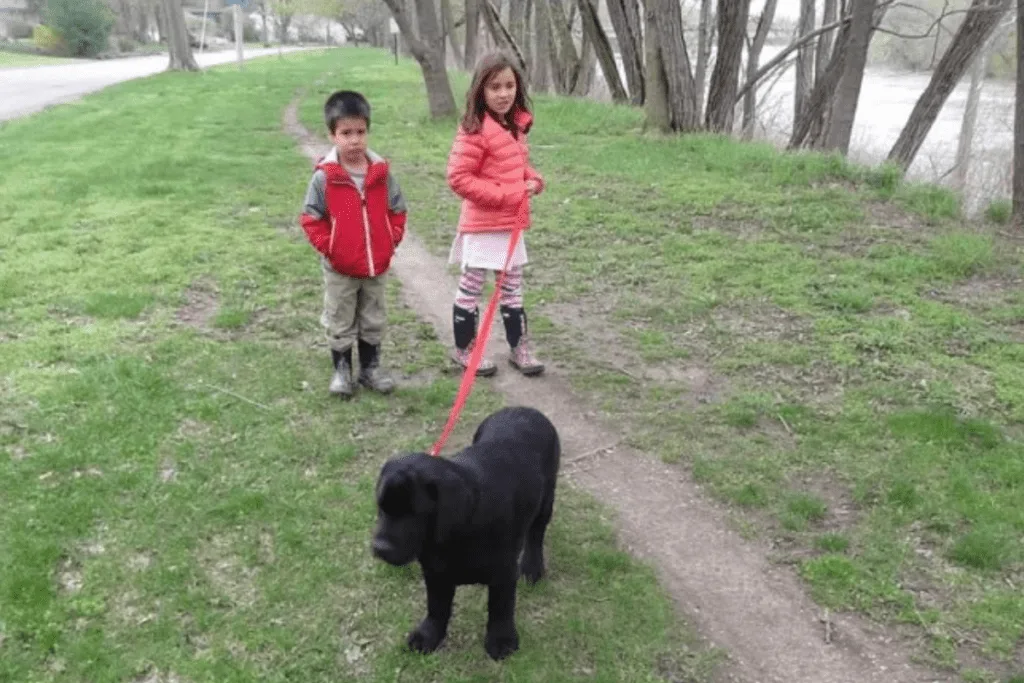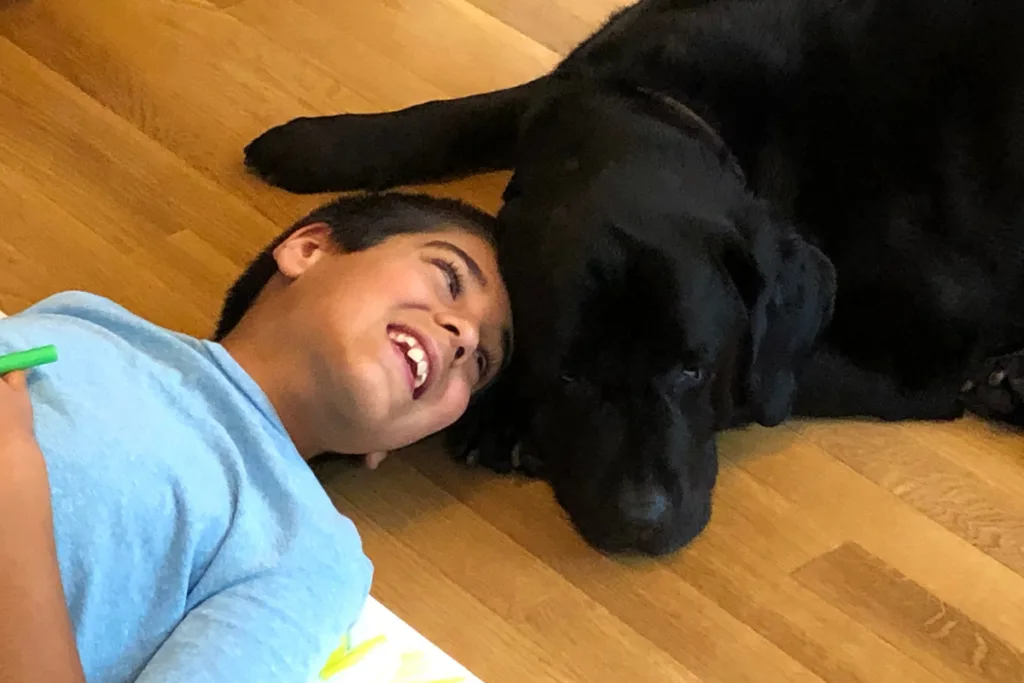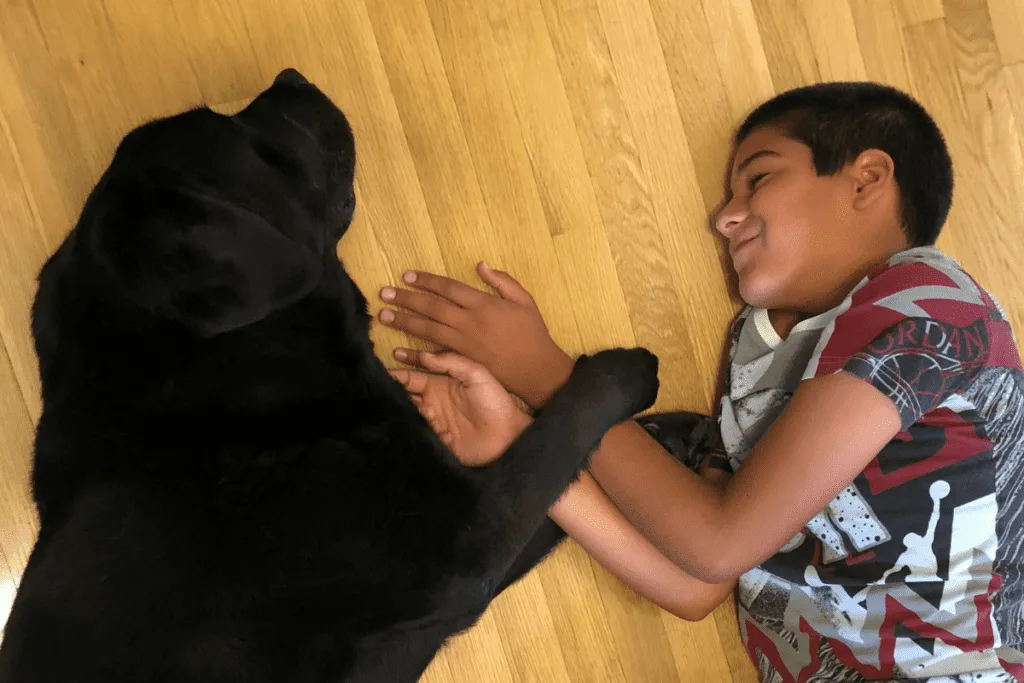For decades Labradors have reigned as the undisputed favorite of American families. Perhaps you are considering dog ownership for the first time and want to discover what makes the Labrador so great with kids.
Or maybe you’re an experienced dog owner who is tempted to skip this article as information you already know, in which case you might be pleasantly surprised.
Labradors are great with kids due to their trustworthy, amiable temperaments, trainability, and perfect size. Modern childhood stressors have created an opportunity for Labradors to be more than pets as they help kids develop healthy emotional skills and physical habits.
Owning dogs used to be a quintessential childhood rite of passage; the picture-perfect home was not complete without the dog on the front lawn.

As society has evolved and changed, children’s stresses and challenges have also changed. Can a Labrador move beyond the role of “hallmark card moments” to something more central, enriching, and growth orientated than that of a simple family pet?
Click Here to Jump to a Section
Historical Reasons Why Labradors Are Great With Kids
Coco Chanel once stated that fashion changes with the winds, but style lasts forever.
Labradors have been “Mr. Popularity” for the past three decades. These dogs hold the key to America’s heart, moving beyond the realm of passing fashion and embracing the charismatic style that keeps people enthralled for generations after generations.
The reasons for Labradors’ historical and current popularity are often well-known; almost every blog you read will cover these salient points, but it is worth noting them again.
Familiarity should not result in the dismissal of the many admirable qualities that a Labrador brings to the home.
Why The Labrador Is The Perfect Size For Kids
Many people, especially those unfamiliar with dogs or who are afraid of dogs, want to get a small dog for their small child.
However, small dogs (i.e., under 10kgs) are not always the ideal dog for rough-and-tumble kids, anxious children, or wobbly toddlers.
Small and toy breed dogs may feel threatened and react defensively if:
- A toddler trips and fall on them
- A child picks them up inappropriately or handles the dog roughly
- If the dog is afraid of being stepped on or bumped while sleeping
A child should always be taught dog safety and how to interact with a dog politely, but children will be children, and they may act impulsively and behave in a way they shouldn’t.
A larger good-tempered dog is less likely to bite than a small anxious dog in these instances.
While small dogs are more likely to act aggressively, many kids feel anxious dealing with giant breed dogs. The child’s fear of these gentle giants is often heightened when the dog unintentionally knocks them over or jumps on them.
The Labradors are the perfect compromise between too small and too large; they’re the “just right” goldilocks choice for kids.
Labradors are the ideal size for a child’s dog:
| Size Parameters | Male Labrador | Female Labrador |
| Height | 22.5 – 24.5” | 21.5 – 23.5” |
| Weight | 65 – 80 lbs | 55 – 70 lbs |
Table 1: Taken from the American Kennel Club website
Can Labradors Be Trusted With Kids?
Dog bites can be life-altering and result in significant injury, especially if a large or giant breed dog inflicts the bite.
When integrating a new dog into the family home, it is essential that they are reliable and trustworthy around kids.
In the ideal world, all dogs and kids would behave respectfully towards each other, and competent adults would supervise all dog-kid interactions.
However, this is the real world, and circumstances are often less than ideal, which is why it is essential to trust both your kid and your dog when they’re interacting with each other.
Veterinarians are widely regarded as the ultimate authority on dog behavior. A study published in 2019 investigated veterinarians’ perceptions of a dog breed’s bite risk and appropriateness for families with children.
Labradors not only had one of the lowest scores for perceived bite risk (4.6%) but were also one of the dog breeds most likely (75.7%) to be recommended for kids by veterinarians.
These results supported the previous study‘s findings, which found that Labradors had the fewest risk factors predicting child-directed aggression.
Overall, most dog professionals would confidently recommend a Labrador for children with one caveat. The Labrador must be well-bred and epitomize the breed’s temperament as laid out by the American Kennel Club (AKC).
Are Labradors Easy To Integrate Into Families (With Kids)?
Many parental figures and caregivers are reluctant to add the burden of pet care to an already busy schedule.
While dog ownership always comes with an unavoidable time and financial commitment, some dog breeds are more high maintenance than others.
Labradors are easy to integrate into a household, as long as:
- You don’t mind shedding
- You can deal with a moderate to high energy dog
- You are willing to commit to training
Labradors are heavy shedders, but unlike Poodles or Afghans, their health will not suffer if they are not groomed every day. A quick brush once a week is typically sufficient for a pet Labrador.
Labradors display a wide range of energy levels within the breed. Juvenile Labradors are chaotic dogs to live with; however, they tend to calm down between 2 to 3yrs.
Families that want a Labrador but can’t cope with a high-energy dog should look at adopting an older dog (i.e., 3yrs or older) or buying a low-energy puppy from a breeder specializing in pet Labradors.
Lastly, Labradors are known to be one of the easiest breeds to train; even novice owners and children can be guided to train a Labrador to a high level successfully. A well-trained, balanced, and polite Labrador is an absolute pleasure!
Labradors Can Assist Kids With Emotional Skills Development
Historically, western culture celebrated individual achievement to the exclusion of group success. Even in team sports, the “superstar” players were heralded ahead of the team effort involved in claiming the win.
Psychologists and even business analysts have repeatedly demonstrated that personal skill is not always sufficient for success. Industry leaders, pivotal game changers, and upcoming disruptors understand the need for other people.
These leaders know how to use prosocial behaviors to motivate and bind a group together in pursuit of a common goal.
Successful individuals know how to lead others and how to harness their own emotions and cognitive skills to the greatest effect.
These skill sets may seem far removed from the day-to-day life of your child, but in reality, the optimal time to nurture and grow these emotional and prosocial skills begin in childhood.
Labradors not only model but can actively encourage and assist your child in developing many of the “success-dependent” emotional skills that will serve them later in life.
The emotional skills listed in this article are not an exhaustive list but rather the key elements that can promote cooperative attitude, address racial divides, and support emotional health.
Can Labradors Help Kids Learn About Empathy?

The basis of lasting prosocial behavior is dependent on the development of empathy. To understand what another person needs, a child first has to learn how to experience and identify with other people’s emotions.
Empathy is a difficult concept for kids to learn but one which can be promoted through the use of Labradors.
A 2015 study investigated empathy, social behaviors, and open or relational aggression according to three experimental conditions:
- Social education with dogs
- Social education without dogs
- Dog attendance without social education
All 3 experimental conditions showed improvements in empathy, social behaviors, and aggression, but only “social education with dogs” resulted in a stable improvement over time.
The dogs used in these studies were Labradors, as this breed is ideal for teaching kids about empathy and other prosocial skills.
The human-orientated sociability of Labradors is encoded into their DNA.
When interacting with a child, the Labrador will actively seek out the child and show different body language in response to the child’s behavior and the Labrador’s moods.
The prosocial behavior and overt body language of the Labrador provide the child and facilitator ample opportunities to explore the possible feelings and experiences of the Labrador.
In this way, the child will gradually develop empathy.
How Do Labradors Facilitate Communication In Kids?

To foster community, combat racism, and develop functional cross-cultural relationships, it is imperative that children learn to communicate effectively and, if necessary, work around language barriers.
Working and training Labradors is a fun way of teaching children about non-verbal communication.
Not only do kids need to learn to pay attention to what their Labradors are trying to “tell” them, but they also need to learn how to communicate their intent to their Labradors in a way that makes sense to the Labradors.
Many kids become frustrated and discouraged if they fail to see progress when training their dogs.
This demotivating level of frustration is often avoided when kids work with Labradors. Almost all humans and dogs work best when taught using positive reinforcement.
Labradors are naturally gregarious dogs who are clever and want to please their owners (i.e., the kids training them). The Labradors’ positive response to the children rewards the kids for their training efforts even if they have less than perfect technique.
The Labradors’ reinforcement of the children’s efforts strengthens their commitment to communicate with a being that doesn’t speak their language.
Labradors Can Teach Kids To Manage Stress Effectively
Childhood stress levels are increasing, causing a deterioration in the mental health of children and teenagers.
Children are becoming more aware of the world around them, picking up on parental stress levels, being exposed to negative social media influences, and experiencing increasing pressure to excel in all areas of life.
It is no wonder that children struggle to moderate their stress response in a world that has many adults dealing with chronic uncontrolled stress. Long-term stress will have serious mental, emotional, and physical consequences.
Learning to manage stress healthily may be one of the most valuable lessons any parent can gift to their child.
Scientific Proof That Dogs Lower Children’s Stress Levels
Two studies (2014 and 2016) used the Trier Social Stress Test to investigate the effect of dogs on children’s psychological (perceived) stress and physiological stress responses.
The “Trier Social Stress Test for Children” (TSTT-C) is a validated test guaranteed to stimulate a stress response in not only children but adults as well!
The TSTT-C requires that children do 5-minutes of public speaking followed by mental arithmetics in front of a panel of unknown judges.
The 2014 study investigated the effects of an unknown dog versus a known human friend and control group (i.e., no support – no friend or dog) on the children’s stress responses.
This study found that the children’s cortisol levels and heart rates were lower when the dog was present versus when a friend was present.
The second study in 2016 compared the perceived and physiological stress levels in children completing the TSTT-C with their dog versus with their parent.
Children showed more petting and dog-seeking behaviors as their stress levels rose; however, the contact and interaction with their dog lowered the children’s cortisol levels and heart rates.
In addition to their reduced physiological stress, children’s perceived stress was lower when supported by their dog compared to experimental conditions where a parent supported them.
Why Are Labradors More Supportive Than Other Dog Breeds?
The above studies did not compare the effects of different dog breeds on children’s stress levels. However, it is not difficult to deduce that Labradors and other human-orientated, low-reactivity breeds would be better suited to the task than overly anxious, aggressive, or aloof dogs.
Labradors are known to be human-orientated cooperative dogs. Within the last 11 years, researchers (2010, 2015, and 2019) have found that one of the key predictors of social behaviors in dogs is human-directed gazing.
In most studies in which Labradors are included, Labradors consistently direct their attention to humans more than other breeds.
The human-orientated approach to life makes Labradors sensitive to the subtle nuances of the human’s facial expressions, body gestures, and movement patterns.
Labradors are more likely to offer intuitive, unconditional support to “their” children than other dog breeds.
The Labradors presence alleviates the child’s sense of “aloneness” and encourages mindfulness through emotional support and physical contact.
Can Labradors Improve Your Kids Physical Health?

Most of us, kids included, operate almost exclusively from behind a desk, cell phone, or other types of screens.
While modern technology has granted us numerous advantages, it has not been without a cost to physical and emotional health.
Modern children face many physical problems that were not seen in previous generations; these include childhood obesity, poor gross motor skills, inadequate balance, heightened fear of physical activities, and delayed or below average physical performance.
Labradors have the potential to aid your child in improving their physical health in a non-stressful, play-based approach.
Labrador Facilitated Childhood Obesity Intervention Strategies
According to the CDC, childhood obesity is a significant cause for concern in the United States. Approximately 20% of all children between the ages of 6yrs to 19yrs struggle with obesity.
Fat-shaming has resulted in a debilitating social stigma that inhibits or evens precludes a positive discussion about weight loss and physical health. Many health professionals are also guilty of an unconscious negative bias towards overweight individuals.
Labradors Reframe The Stigma Surrounding Childhood Obesity
Labradors provide a unique opportunity for parents and health care professionals to introduce a non-confrontational discussion on obesity and the health consequences of obesity.
Many Labradors are prone to obesity and excessive weight gain due to the deletion of the POMC gene.
When addressing the weight concerns of an obese Labrador, children are provided an opening to discuss their feeling about obesity, weight loss and take a proactive role in devising a weight-loss program for their dog.
By using the overweight Labrador as a focus for the discussion, children can address their obesity-related issues as they learn that:
- Obesity does not devalue a person’s (or Labrador’s) worth or attractiveness
- Obesity affects your quality of life and has long-term health consequences
- Weight loss is challenging and should be approached with empathy for the person (or Labrador) losing weight
- Weight-loss takes time
- Weight loss and weight maintenance are the product of good lifestyle habits and not yo-yo dieting.
- Weight loss can be fun if you do it through play and with the support of friends.
These discussions and reframing of childhood obesity and weight loss are relevant to children struggling with weight issues and “normal weight” children.
By talking about the problems their overweight Labrador faces, parents, teachers, and other significant adults can help the children develop empathy for those facing different challenges.
Can Labradors Encourage Kids To Lose Weight?
As mentioned previously, weight loss is a difficult challenge to overcome; however, completing the weight loss program with a friend increases the likelihood of long-term results.
Children who are encouraged to walk and play with their Labradors unknowingly establish healthy weight-loss and maintenance habits.
Participating in physical activity and weight loss with their best friend (i.e., Labrador) shifts the child’s focus from the pain of physical exertion to their Labrador’s needs.
Martin, Wood, and Christian found that primary and secondary school children who walked or played energetically with their dogs for more than 1 hour per week were significantly more likely to fall within the national physical activity recommendation.
Increasing physical activity is critical to weight loss and the prevention of unhealthy weight gain.
Labrador Driven Play-Based Development Of Gross-Motor Skills

It is not only obesity that is a product of children’s sedentary lifestyles. An increasing number of toddlers, preteens, and even teenagers are referred to occupational therapists for assistance with gross motor skills.
Gross motor skills refer to large body movements that require muscle stabilization, balance, hand-eye coordination, proprioception, and environmental navigation.
Examples of gross motor skills include:
- Running
- Jumping
- Throwing or catching a ball
- Balancing on one leg to get dressed, e.g., putting on pants
- Lifting the head when in a prone position
- Confidently walking on a variety of surfaces
- Climbing over obstacles
- Swimming
Dog-inclusive play improves children’s independent mobility and gross motor skills.
Playing with a Labrador is akin to having a home-based occupational therapist for your child. Labradors are ideally suited for the task of therapists as the breed:
- Happily, plays fetch for hours on end; the child is given an opportunity to develop hand-eye coordination and ball throwing skills.
- Willing to swim with children, this breed is known for its water-loving attitudes. It’s essential that a responsible adult strictly supervise all water-based activities and that both the child and Labrador behave safely in and around water.
- Will be your child’s companion as the two (Labrador and child) set out adventuring, e.g., exploring under rocks, climbing over logs, and walking on uneven surfaces.
- Is easy to train and can be taught low-level agility (including tunnels, ramps, jumps, weaving poles, etc.). Children teaching Labradors to navigate an agility course will also need to navigate the obstacles with their dog, developing their balance, physical fitness, and confidence.
Final Thoughts
The Labradors’ happy-go-lucky approach to life, trustworthiness and willingness to bond to “their” kids have made them a firm favorite with parents and children alike.
However, the role of the family Labrador is beginning to evolve and change.
Previously a childhood Labrador was seen as a rite of passage, and the dog was viewed more as an “add-on” than an instrumental part of a child’s life.
Modern research has highlighted the manifold emotional and physical benefits that can be achieved through the interactions of a child and Labrador.
It is essential to remain aware of the fact that not all Labradors live up to the breed standard, and there is a wide degree of intra-breed variations.
Prospective buyers should always seek the counsel of respected dog-orientated professionals (i.e., breed organizations, veterinarians, dog trainers, and breeders) to guide them in purchasing or adopting a Labrador.
